#Myojo
Text
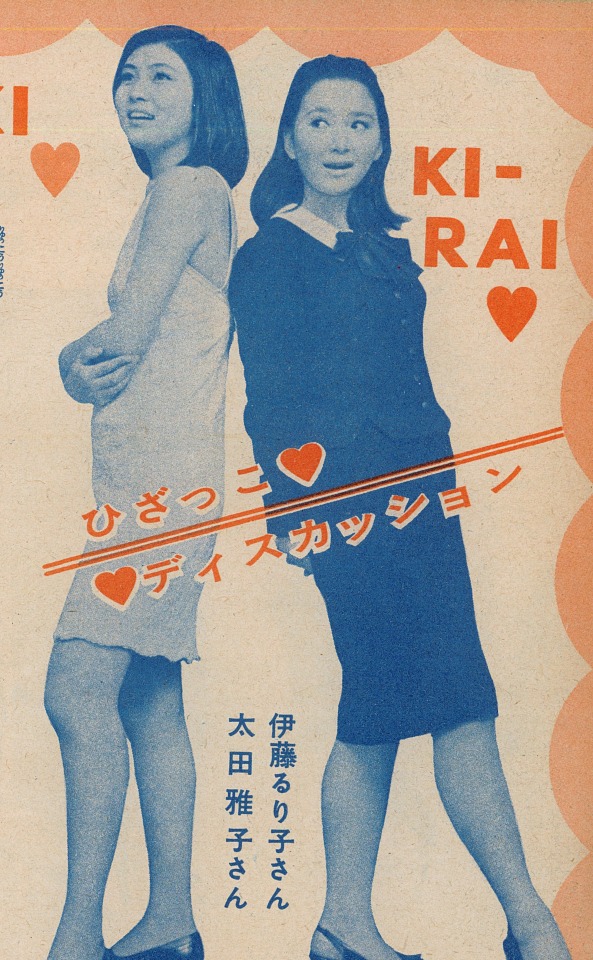
Meiko Kaji (梶芽衣子) and Ruriko Ito (伊藤るり子).
Scanned from the June 1966 issue of Myojo (明星).
14 notes
·
View notes
Text
J A P A N o F I L E S # 8 -- Chronicle of Starting a Shina Soba Shop

[ The last JAPANoFILES feature was written eleven years ago. The post reached an audience of many thousands and helped create awareness about a powerful videogame creation left buried beneath the snow: Mizzurna Falls. One of its readers went on to translate the game to English, in fact. This is an impossible act to follow. In reviewing the original intention of these articles, it occurred to me that if I’m to give continuity to this effort, I should carry on seeking items of both cultural and videoludic relevance that have slipped between the cracks of history. Today’s story was one I began writing shortly before this tumbleblog hibernated and that, to my knowledge, has not yet been satisfactorily told until now by any of my fellow japanophiles. As you read it, I hope to instil in you the same gemütlichkeit you’d get from a steaming bowl of noodles on a cold winter evening.]

From the very onset, チャルメラ suggests a fascinating divide: although the title and cover art will hardly resonate with western observers, virtually anyone in Japan will instantly recognize what it is all about. To them, this is as household a name as they come, and one synonymous with precooked noodle deliciousness and convenience for over half a century.
Charumera is a much beloved line of instant noodle products introduced by Myojo Foods, a company whose foundations date back to the mid-twentieth century. Its name is interchangeable for cup noodles in many areas of Japan and the Japanese diaspora, including Brazil. The company grew a reputation for introducing some of the early revolutions in this food category that we now take for granted. In 1961, it was the first to propose the concept of cup noodles, a simplified meal preparation method made possible by ice cream type paper containers capable of withstanding the pouring of boiling water. Many misattribute this invention to Nissin due to the fact that Myojo, who lacked the wherewithal to file for a utility patent, could only profit out of their idea by selling production and commercialization rights to that prosperous food giant. The Tokyo-based company was also the first to usher in the now ubiquitous separate powder flavouring bags, initially under the name Myojo Ramen in 1962, and later rebranded as Myojo Charumera in 1966, with an improved formula that made this a reference to a fast-food seeking population.
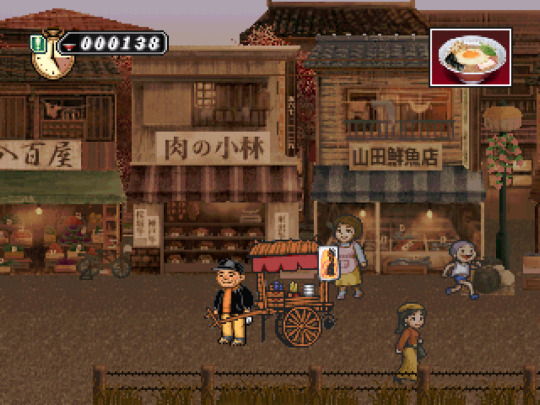
The man in the above cover art for this Playstation game adaptation, also titled Charumera, consists of the product's very own mascot, whom the Japanese lovingly call Ojisan (uncle). Few could have predicted that he would ever star in a videogame of his own. Created by Bits Laboratory and published by Victor Interactive Software on November 1999, it is unclear whether the game was sponsored or merely certified by Myojo. In the absence of more concrete information, all appears to indicate that this project was developed with the clear intent to pay homage to the brand and iconic character, only tangentially serving the purpose of advertising.
~ An ageless man carries the weight of tradition ~
In Charumera, the good uncle merrily pushes his Yatai about the streets of a fictitious town at the height of the Shōwa era. Momentarily, if the player relinquishes the control pad, he may feel at ease to wipe the sweat off his face with his chef's side towel. The streets are wide and long and barely any automobiles can be spotted. He does not speak during any of the ample verbal exchanges, although a narrator of unknown origin may on occasion report on his sentiments and reactions. He is simultaneously the central component of the game and a mere spectator to unfolding events.

A map of the aptly-named Naruto town, itself a microcosmic representation of Japan in the fifties and its dichotomy between urban and rural zones.
One part of the game has the player engage in the basic management of a mobile food stand business, starting with an understanding of the different areas of Naruto, its distant farm fields, a fishing wharf, sooty industrial zone and the bustling city centre. Each turn represents a business day, lasting from late afternoon to the wee hours of the night. Different locations at different times of the day represent varying degrees of foot traffic.
When the turn is complete, the player is free to indulge in culinary research and development, customizing all aspects of a ramen dish: the different varieties of noodles, type of bowl, seasonings, stock base and toppings. At first, the selection is limited to a set of base ingredients that can be expanded by the discovery of new areas and characters, some of them tradesmen and produce suppliers. The best selection of components ensures the most customers and, consequently, the most servings. Currency does not exist in the game. Its functional end is reached when enough meals been served for the empty bowl stack to rise above the height of the fabled mount Fuji. No small feat for a self-employed man of advancing years.
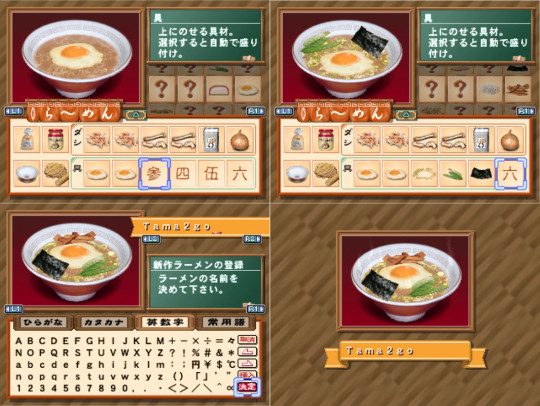
The interface for assembling Ramen bowls puts one in mind of Cybernetic’s less-than-stellar Pizza Tycoon, enabled by the overlapping of transparent bitmaps. The final presentation adds a plume of smoke to what may well turn out to be a mouth-watering success.
Charming as the business simulation aspect of the game system may be, at its heart, Charumera is an adventure centred around the exploration of a city and its denizens; one where the main goal is to bring people together through a common appreciation of the quintessential Japanese delicacy that is ramen. Scattered across the different areas, and at different times of the day, exist a number of key characters who, unlike the average passerby, will not only stop for nutritious soup but also prompt a conversation. This is done, primarily, in order for players to receive an assessment of their dishes. Some of these self-professed critics will be quite forthcoming in their comments, suggesting the flavor profile or combination of fixings most likely to please them. Others add difficulty to the game by keeping their contributions brief and enigmatic. By learning of their preferences, the player is invited to adjust the composition of the dishes and return to the same location, at the same hour of the day, to attempt another serving and achieve complete satisfaction.
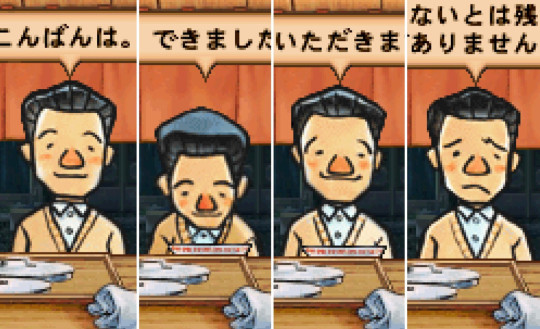
Customers tasting Ojisan’s cookery will react with different facial expressions. Some, on the other hand, will slurp his stock while remaining silent and expressionless. To captivate the more demanding customers, subtler signals need to be observed.
At times, a fully content customer's quest will be completed with a round of smiles, praise and gratitude. But on occasion, these may set in motion a more layered story to be unfolded over the remaining course of the game. An illustrative example of this is the recluse monk who is undergoing a long prayer exercise, and of whose rigorously vegeterian dietary needs can only be learned through the input from other characters who relate the motive of his abstinence. The developers also integrated a clever mechanism to aid in the understanding of what constitutes a fine plate of noodles by allowing the player to regularly visit the home of one of uncle’s best friends, a taxi driver who will be delighted to perform a tasting and attribute a score.

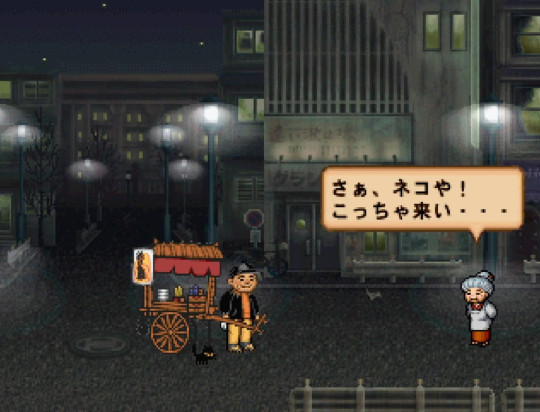
The evolution of Ojisan’s design over the years observed some changes including a much needed footgear upgrade from hardwood zori to a snug pair of sneakers (left). The alternative, far less inspired cover art for the game's second edition (right). The black cat Suzuneko only makes its first appearance a couple of hours into the game as a part of a substory (bottom).
~ Sweet shawm music ~
The long tradition of Yatai-wheeling cooks is only supplanted in age by ramen itself. Decades before it came to known by its present name, noodle soup was commonly referred to in Japan as Shina Soba, a clear enough reference to its nonetheless opaque Chinese ancestry. Japan’s fast-paced industrial development in the late 19th century caused severe economic and demographic changes. A host of policies adopted by the government expedited the rift between an increasingly impoverished and isolated countryside population, for whom labour-intensive agriculture was no longer a profitable activity in view of neighbouring competition. This resulted in an exodus to the cities, in droves, and the search for the opportunity of low-level employment in manufacturing. The extended work hours and taxing duties of factories paved the way for a new type of meal, one substantial enough to sustain workers and at the same time affordable for regular consumption.
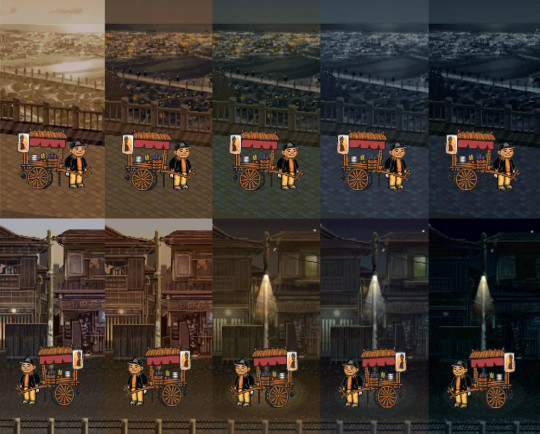
The passing of time is strikingly reflected in the backgrounds, the result of a clever combination of gradual colour scheme alterations and the loading of new bitmaps. The switch of music themes equally signals the change.
Wheat flour imports from Korea and Taiwan being more affordable than Japanese rice, this new noodle soup found its way among the most predominant food offerings of the early 20th century; first introduced by Chinese emigrant-owned eateries and later integrated into even the most traditional Japanese restaurants in view of its high demand. Yatai, already used for many decades in Japan to bring prepared food to residences, were one of the prime vehicles behind the propagation of Shina Soba by keeping this delicacy in permanently close reach.

As illustrated by the emblematic Charumera product logo, the sounding of the horn is an instrumental ritual of food cart owners, enabling their presence to be known. Conversely, this is a recurring action performed in the game with the pressing of the O button. Once the sound plays, bystanders will gather around the ever-cheerful uncle.
The name ‘charumera’ refers to a double-reed woodwind instrument that is said to have derived from ‘charamela’ – Portuguese for shawm -, hinting at a possible introduction to the Japanese by way of Christian missionaries from that provenance sometime during the 16th century. The simplicity of the instrument made it popular among pushcart owners, not only because its sound signalled their impending arrival, but also due to the clever employment of signature melodies in what can only be described as a primordial manifestation of brand awareness. All these practices are exquisitely demonstrated in a scene from Yasujirō Ozu’s 1936 film Hitori Musuko (The Only Son). Needless to say, a viewing of the entire picture is most advised.
~ Ramen as the expression of longing for a bygone era ~
In the present, where connections to history have been severed, ramen is a tool to rearticulate the charm of Japan’s traditions. - Hayamizu Kenrō
There couldn’t have been a more appropriate moment to reintroduce Charumera. Ramen is more of a nipponic cuisine staple than it has ever been before, sustaining its high demand across the islands, each region unyieldingly asserting the superiority of their own rendition. As for the rest of the world, ramen has long expanded beyond the constricted cubbyholes in which it remained for decades, when only urbane gourmets or ablutophobic otakus dared to publicly utter the word above a whisper.
Japan is presently witnessing an intriguing wave of nostalgia for the Showa era, as evidenced by the multitude of visitors to the recently inaugurated Yūhi No Oka Shōtengai (Sunset Hill Shopping Street) at Seibuen Yenchi, a massive theme part located in the Saitama prefecture of Tokyo. The concept behind this attraction is to recreate the life of a small shopping district from the 1960s, faithfully capturing the architecture, décor, fashion, transportation, advertising, stores and products from this period. Visitors seem delighted at the prospect of evasion to what they perceive as an easier, more compassionate style of living. (recommended viewing: NHK feature "Showa Nostalgia", May 2022).

A similar ideal is humbly pursued with this unique software: the use of modern technologies as a medium to connect to younger game-playing audiences, reciting a tale from a time when simple pleasures such as a cup of hot soup were deemed an enriching experience, for those preparing and feasting on it alike. Its only message is the celebration of amity and unity, as conveyed by its ultimate purpose: to weave lasting bonds with the community, establish the business as a local institution by acts of kindness and cooperation, inspire followers through hard work ethics and gain full support of every element of society. Its period recreation prowess may lack the verve of SEGA’s seminal Shenmue, published that same year. The exploits of its game system surely pale in comparison with the gargantuan catalogue of expansive role-playing games for which this epoch came to be celebrated. This is, after all, the product of nearly self-sufficient designers making as good a use of their previously acquired skills and experience as was permitted by the modesty of the budget in reach. In true indie form, it nevertheless excels at what the majority of the towering productions of the day failed to possess – a soul.
~ Heisei 11: the year of digital noodles ~
Though infrequent at the turn of the century, food and cooking themed video games have witnessed a vast expansion in popularity, presently existing in numbers sufficient to constitute a subgenre all their own. The ordinariness of most proposals in this category of late, however, beg for a tribute to earlier accomplishments. In general, food has been a pervasive theme in Japanese games since the early 1980s – after all, what is Pac-Man’s main premise if not to devour? For the purposes of this article, a more refined search is required to single out those pertinent creations still shrouded in relative obscurity.
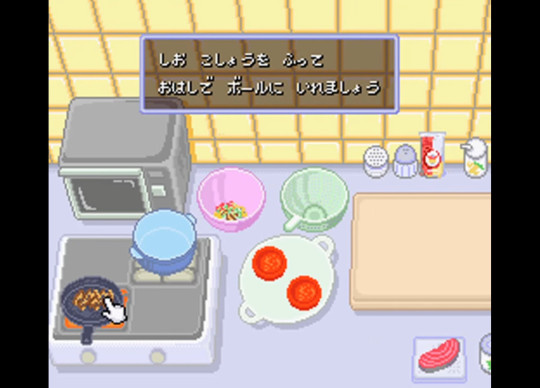
Ajinomoto's foray into the world of video game product placement may have been the unintentional inspiration for a brave new console game category.
Certainly, one of the first Japanese games on the subject of cooking was Motoko-chan no Wonder Kitchen, a 1993 promotional Super Famicom cartridge obtainable only in return for mailing Ajinomoto mayonnaise cut-out label seals, all part of a contest for which ten thousand units were produced. The relevance of this game cannot be overstated: not only does it produce an early example of a stunningly functional dish assembly minigame, it also represents the early days of that obscure Japanese tradition wherein the video game space is permeated by advertising from large-scale food corporations.
A year later, the doyen of bishōjo games, KID, teamed up with Nissin Foods to give digital life to UFO Kamen Yakisoban, the superhero from their saucer-shaped yakisoba cup noodle ad, this time for an eccentric Super Famicom beat ‘em up in which the kitchen remains off-limits. In early 1999, KID would in turn partner with PepsiCo for the production of Pepsiman on the Playstation, Japan’s most recognizable face for the world-renowned soft drink, a game that garnered cult following among western players in the early 2000s.
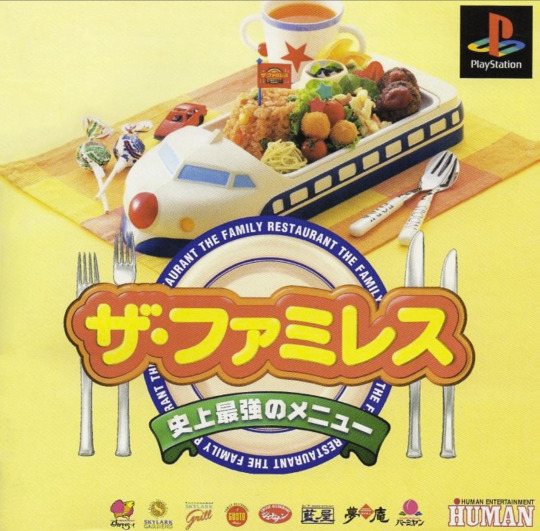
It never ceases to amaze how many ports of The Family Restaurant hit the market between 1998 and 2000 alone. Just a year after the original Masterpiece game, a slightly improved version developed by ArtDink also made its way to the PC. There were also three editions of the game for the Playstation, each a unique variation of the base design. Notably, the Human edition included a partnership deal with the Skylark group, advertising a handful of their most beloved restaurant chains. The above cover art boasts the logos for Yumean, Aiya, Jonathan, Gusto and the temple of Chinese food deliciousness, Bamiyan.
Other honourable mentions from the latter half of the decade include Burger Burger, a Maxis/Bullfrog styled fast-food chain restaurant strategy simulator designed by board game designer and 1988 Monopoly word-champion Hyakuta Ikuo; the 1998 Masterpiece personal computer game Za Famiresu (The Family Restaurant), another restaurant business sim ported to the Playstation in 1999 by Human Entertainment, in an edition rececing the sponsorship from the major restaurant group Skylark; and Cooking Fighter Hao, a remarkably unusual Nippon-Ichi combat game in which the player slashes live animals for meals to be prepared.

Ore No Ryouru demands impeccable chopping skills at the cost of a few fingers (left). A leering look at historical Japanese society, Ramen Bashi is best described as a game of customs (right).
The year of 1999 represented a peak of creativity within the genre. Invariably, the first piece of evidence sustaining this claim is Ore No Ryouri, the result of a partnership between Sony and Argent intended to support marketing efforts for the original Dual Shock controller. Much like Saru Getchu, the game makes sensible use of the dual sticks in replicating the taxing kinesis that restaurant-grade food preparation entails. The game was a small success in Japan due to its hilarity and frantic pace, meriting a Playstation the Best edition and PS3/Vita rerelease.
Making its appearance mere weeks before Charumera, Ramen Bashi, developed by Media Entertainment, is another triumph from that same year, one that remains largely unappreciated even among Japanese players. Unlike the aforementioned oddities, novelties and brazen publicity stunts, this is a game of some depth and complexity. In it, the player assumes the role of a soldier demobilized from Siberia after the war who takes over his father’s ramen shop, finding himself encircled by a society of commoners, thugs and other such unpleasant people that, throughout the four decades during which the game takes place, ceaselessly prey on his Hakaiou-like, short-tempered nature. For every ounce of heart that Charumera possesses, Ramen Bashi matches it with its peculiar brand of satire and sardonic humour. So caustic, in fact, that the studio was forced to tone it down in for their ensuing gourmet series, referred to by some as the holy trinity of PlayStation cooking games - Yakiniku Bugyo, Nabe Kazoku, and Yakitori Musume. An article of similar scope to this one has yet to be written about any of them.
More JAPANoFILES features
JAPANoFILES #7 - Country of Bears and Burgers
JAPANoFILES #6 - Violent Cop
#playstation#sony#ramen#myojo#nissin#charumera#instant ramen#videogame#obscure games#obscure game#Japanese food
31 notes
·
View notes
Text
Myojo 6/2023 - Matsui Minato (và nhận xét của các thành viên khác)
Nguồn: https://www.tumblr.com/kaleidoruby/719336753759240192/translation-myojo-june-2023-impactors-matsui?source=share
Trong số này, Minato sẽ kể 3 điều về bản thân và 3 sự kiện quan trọng trong cuộc đời. Ngoài ra còn có lời bình ngắn của các thành viên khác về Minato!
Minato’s NAVI
Em trai tôi chào đời đã để lại ấn tượng mạnh mẽ trong ký ức tuổi thơ ngọt ngào của tôi.
Hồi mới sinh, mặt mũi tôi tím tái hết cả nên phải nhập viện ngay lập tức. Sau đó thì tôi hay ốm lắm, và có vẻ mẹ tôi đã phải trải qua khoảng thời gian khá vất vả khi chăm sóc tôi. Lúc đi học mẫu giáo, tôi là một tên nhóc mít ướt. Hình như cứ khi nào xe buýt của trường đến đón tôi và mẹ vẫy tay chào tạm biệt thì tôi lại bắt đầu nức nở. Rồi đến khi em trai chào đời, bố mẹ lúc đó phân vân giữa 2 cái tên nên họ đã hỏi tôi “Con thích cái nào hơn?” và tôi nhớ là mình đã ngay lập tức chọn được 1 cái tên cho em ấy.
Tháng ngày tiểu học của tôi trôi qua yên bình lắm. Tôi có rất nhiều kỷ niệm với gia đình trong những kỳ nghỉ.
Thời tiểu học, tôi không phải dạng năng nổ cho lắm. Điểm số thì bình bình, không tốt cũng không kém, nhưng cuối cùng lại được làm lớp trưởng. Sau đấy không hiểu vì lý do gì mà tôi ứng cử vào hội học sinh của trường, rồi còn lên làm chủ tịch hội học sinh nữa cơ. Nhờ thế tôi đã có khá nhiều bài phát biểu trước mọi người. Cuối tuần thì tôi sẽ đến trung tâm thương mại với bố và em trai, cùng chơi máy gắp thú, còn khi kỳ nghỉ hè tới thì cả nhà sẽ về quê mẹ tôi ở tỉnh Toyama.
Tôi thích làm “cháu trai” hơn là “bạn trai”
Khi mới vào công ty, tôi đã phải vật lộn với vũ đạo nhiều lắm. Mặc dù vẫn chưa đủ tự tin nhưng tôi thực sự rất muốn được nhảy trong Spring Paradise, thế nên trước giờ diễn tập 1 tiếng, tôi đã cùng nhóm trưởng, Tsubaki-kun và Shun luyện tập. Nhưng thỉnh thoảng tôi sẽ bị kiệt sức trong những buổi tập như thế (cười). Tôi biết có những người coi tôi như “bạn trai” hoặc “em trai” nhưng thành thật mà nói thì có vẻ danh phận đó hơi nặng nề với tôi... Tôi sẽ rất vui nếu được coi như 1 đứa cháu trai đáng yêu của mọi người.
3 sự kiện quan trọng trong cuộc đời tôi.
1. Năm 4 tuổi: “Một bi kịch đau đớn đến mức tôi không thể nói nên lời.”
Chuyện là bố tôi đèo tôi ôm trái bóng rổ ngồi ở yên sau xe đạp, lúc đó chân tôi đang thả lủng lẳng, thế rồi nó bị cuốn vào nan hoa bánh sau.
2. Năm 7 tuổi: “Tôi bắt đầu có những tiết học trong một thế giới toàn các bạn nữ.”
Tôi bắt đầu học múa bale cổ điển năm 7 tuổi. Ở đó toàn là con gái thôi, đến tận khi tôi lên lớp 3 cũng chẳng có lớp nào cho riêng con trai cả, nên cứ học ở đó như vậy thôi à.
3. Năm 9 tuổi: “Tôi thấy Arashi trên một chương trình âm nhạc, đó là lúc tôi quyết định nộp đơn đăng ký.”
Arashi hát, nhảy, và thay đổi hàng loạt concept, trông họ ngầu~ không chịu nổi luôn. Lúc đó tôi đã nghĩ “Mình muốn được như họ!” và rồi gửi đơn đăng ký.
Nhận xét của các thành viên
Motoi: Em ấy là thành viên trẻ nhất của IMPACTors nên lúc nào cũng như đứa em trai bé bỏng trong nhóm, nhưng ở nhà thì em ấy là anh cả và còn có một cậu em trai ở dưới nữa. Tôi nghĩ nhiều lúc em ấy cũng ra dáng anh lớn một cách đáng ngạc nhiên, ẻm quan tâm đến mọi người lắm. Em trai của Minato rất yêu quý anh mình.
Tsubaki: Minato là thành viên hay nhớ những thứ tiểu tiết nhất. Cứ mỗi khi chúng tôi nói chuyện gì mà đến cái khúc “Cho xin một ví dụ được không?” thì em ấy có thể trả lời được rất nhanh. Kể cả lúc tập vũ đạo cũng thế, em ấy nhớ được những gì mọi người bàn bạc và điều đó đã giúp ích cho chúng tôi rất nhiều.
Kageyama: Tôi ngưỡng mộ nhất là những thứ khiến tôi cảm thấy bản thân nam tính, ví dụ như khi tôi oẳn tù tì thua ẻm và phải đi mua đồ uống chẳng hạn. Lạ một cái là tôi thua nhưng đến lúc đi mua đồ uống thì lại thấy có chút tự hào... Có khi nào tôi thấy mình thật ngầu trước mặt ẻm không nhỉ!? (cười)
Arata: Minato ghét kim tiêm. Lúc đến phòng khám để tiêm chủng cậu ấy cứ kêu “Không biết có đau không nhỉ?” rồi thì “Không muốn tiêm đâu.” Khi chúng tôi đi bấm khuyên tai cũng thế luôn, mà kể cả bấm xong rồi cậu ấy cũng như đứa trẻ con 5 tuổi ấy, không chịu đau nổi.
Taiga: Em ấy rất trân trọng những món đồ của mình. Và bởi ẻm quý trọng từng thứ một như thế nên tôi luôn có ấn tượng rất mạnh mẽ rằng “A, Minato sẽ mặc cái này.” hay “Đây là túi của em ấy.” Ẻm cũng rất hay đội chiếc mũ được Jinguji-kun tặng.
Yokohara: Có lần tôi nói chuyện về một người bạn thân của tôi, là nam, thế rồi em ấy bảo “Em muốn gặp người đó!” Tôi đã từ chối nhưng xong ẻm cứ nài nỉ mãi, thế nên họ đã gặp nhau một lần. Minato là thành viên duy nhất biết vòng bạn bè của tôi.

#impactors#IMP.#matsui minato#motoi shunsuke#tsubaki taiga#kageyama takuya#sato arata#suzuki taiga#yokohara yuki#myojo
0 notes
Text
youtube
tim to cook
#myojo#ramen#noodle#noodles#the ramen rater#theramenrater#food#soup#hans lienesch#instant#instant noodles#Youtube
0 notes
Photo

#カップ麺 #Cupnoodle #焼きそば #Yakisoba #FriedNoodles #一平ちゃん #Ippeichan #明星 #Myojo #夜店の焼きそば #YomiseNoYakisoba #からしマヨネーズ #mayonnaise #Japan #日本 #ivvaDOTinfo #ivva https://www.instagram.com/p/Cmn-uDkSXI4/?igshid=NGJjMDIxMWI=
#カップ麺#cupnoodle#焼きそば#yakisoba#friednoodles#一平ちゃん#ippeichan#明星#myojo#夜店の焼きそば#yomisenoyakisoba#からしマヨネーズ#mayonnaise#japan#日本#ivvadotinfo#ivva
1 note
·
View note
Text
Translation: 💗Sakuma Myojo zero point interview May 2022
When he's handling the animals that he loves so dearly, he thinks only about what's right in front of him. By connecting with them in such a way, Sakuma Daisuke's heart becomes pure.
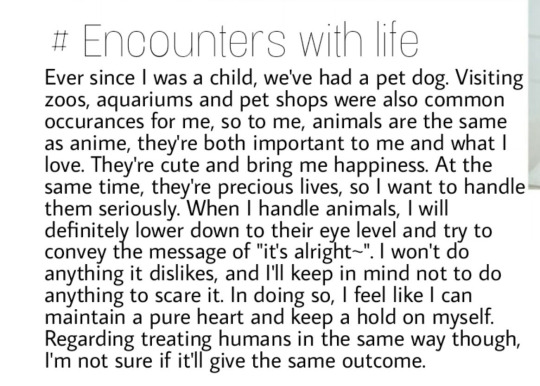



0 notes
Photo


221022 🌼 Instagram Update
qpitdef : Myojo12月号掲載させて頂きました💜✨
絶賛発売中です!
宜しくお願いします👏
#myojo
@myojo_henshu
#山下幸輝
0 notes
Text
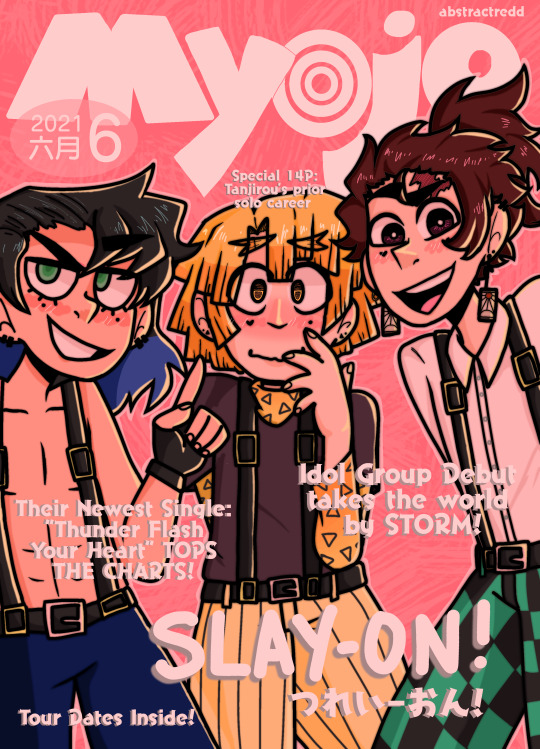

#okay here’s some kny idol au art#from june 2021 GAW DAMN#myojo is an actual magazine#slayyyy#i might post more idk#this is the only fully finished colored drawing#the rest of the idol su art is pretty much sketches and doodles#my art#kimetsu no yaiba#kny#kny idol au#demon slayer fanart#kny fanart#zenitsu agatsuma#agatsuma zenitsu#tanjirou kamado#kamado tanjirou#inosuke hashiriba#hashibira inosuke#zenitsu#tanjirou#inosuke#kamaboko squad
91 notes
·
View notes
Photo
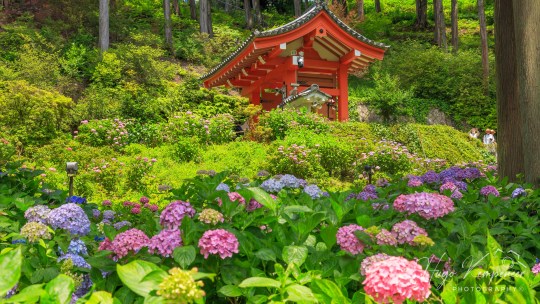
Mimuroto-ji Temple is one of the most impressive sites to see the hydrangea or ajisai in its most spectacular display. Daytime and during evening light-up.
33 notes
·
View notes
Text



Tokaku Azuma
Tokaku Azuma (東 兎角) is one of the assassins posing as a student enrolled in Myojo Private School's 10th Year Class Black. She, like the other members of the Class Black, is tasked with the mission of eliminating their target: Haru Ichinose.

#I am loving thisss#she is a vibe#tokaku azuma#Akuma no Riddle#Myojo Private School's 10th Year Class Black#haru ichinose#Riddle Story of Devil#anime#animecore#assassins#anime news#anime dub#anime and manga#action anime#anime blog#anime season#manga
15 notes
·
View notes
Text

A 19 year old Meiko Kaji (梶芽衣子).
Scanned from the June 1966 issue of Myojo (明星).
24 notes
·
View notes
Text
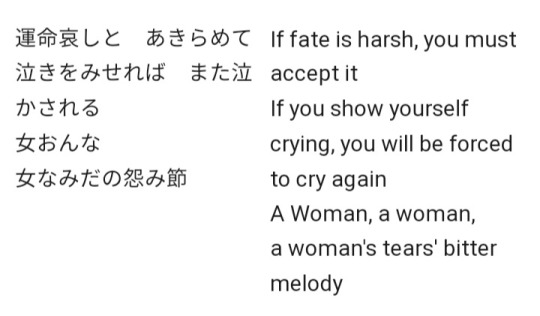
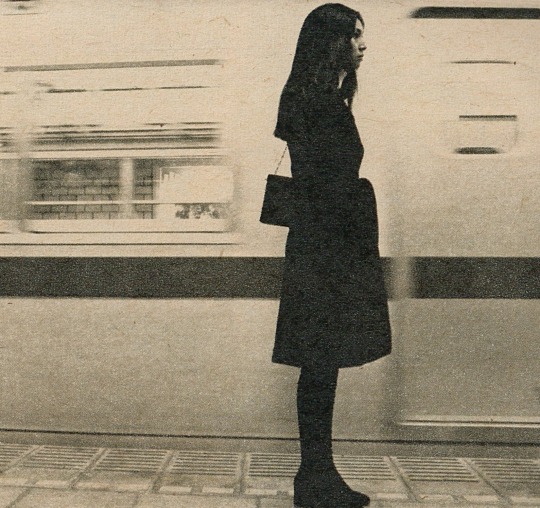
Urami bushi(怨み節), Meiko Kaji//Meiko Kaji (梶芽衣子), Scanned from Shukan Myojo (週刊明星), Feb 25, 1973.
#meiko kaji#urami bushi#web weaving#quotes#words#poetry#woman's bitter melody#grudge#hate#japanese#shukan myojo#fate#womanhood
37 notes
·
View notes
Text

IT'S OUTER TIME BABY 💫
#karamell's utmv anime girl thing#karamell doodles#outer sans#myojo fukui#i know i said i'd post horror later but... outer.......#oh yeah and i also bothered to give them all actual anime girl-esque names#so that if some rando comes around and takes a peek at my work#i don't have to explain my uber cringe reasoning about how the hell this relates to undertale#(don't worry i did put a bit of thought into them 😅)#utmv#undertale au#outertale#outertale sans#fem!outer#why do we need so many tags for everything
2 notes
·
View notes
Note
The door to the student council room is flung open, and a familiar Blonde Boy dramatically enters.
"Myojo, my good friend! I apologize for my unfortunately prolonged absence, but I have returned and am more than ready to resume my duties!"
[@daily-rubbersoul-redux] (oopsies i forgot to do this earlier-)
(you're all good don't worry shook-)
"Ah!" Myojo stands up from the desk and sets aside the papers, rushing over to give his friend a quick, light squeeze before backing away. "I'm glad to see you back here in what I hope is one piece!"
He gestures to the (rather empty, surprisingly) set of folders on the table. "I've been keeping the fort held down while you've been off, I hope I haven't disorganized any work you'd been doing prior, eheh..."
5 notes
·
View notes
Text
oh doooooood
0 notes
